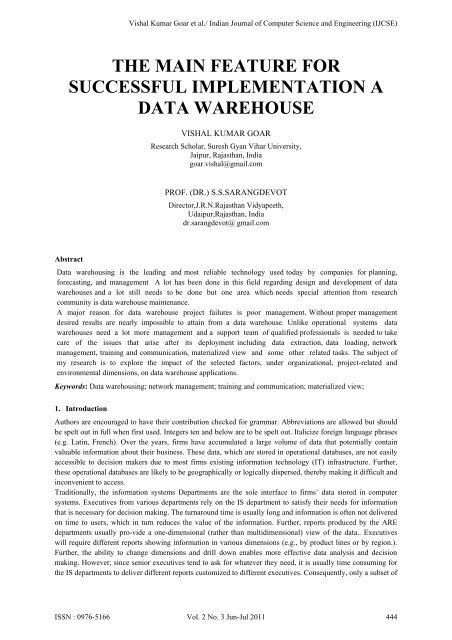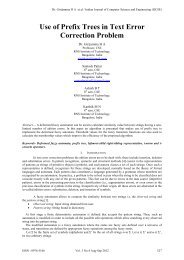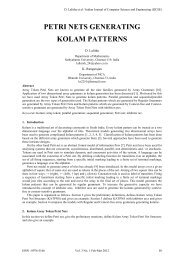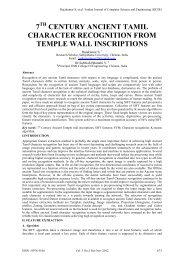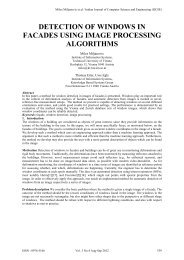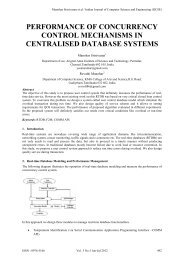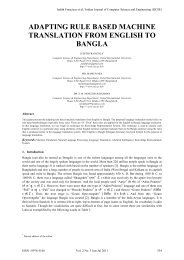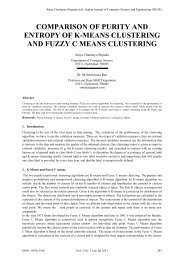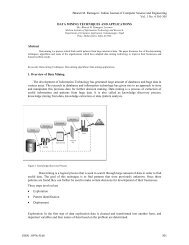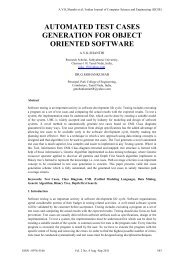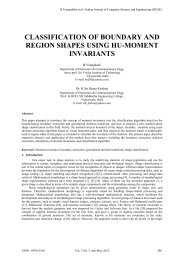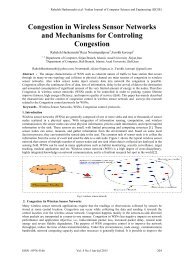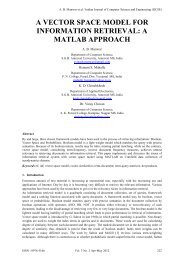the main feature for successful implementation a data warehouse
the main feature for successful implementation a data warehouse
the main feature for successful implementation a data warehouse
You also want an ePaper? Increase the reach of your titles
YUMPU automatically turns print PDFs into web optimized ePapers that Google loves.
Vishal Kumar Goar et al./ Indian Journal of Computer Science and Engineering (IJCSE)<br />
THE MAIN FEATURE FOR<br />
SUCCESSFUL IMPLEMENTATION A<br />
DATA WAREHOUSE<br />
VISHAL KUMAR GOAR<br />
Research Scholar, Suresh Gyan Vihar University,<br />
Jaipur, Rajasthan, India<br />
goar.vishal@gmail.com<br />
PROF. (DR.) S.S.SARANGDEVOT<br />
Director,J.R.N.Rajasthan Vidyapeeth,<br />
Udaipur,Rajasthan, India<br />
dr.sarangdevot@ gmail.com<br />
Abstract<br />
Data warehousing is <strong>the</strong> leading and most reliable technology used today by companies <strong>for</strong> planning,<br />
<strong>for</strong>ecasting, and management A lot has been done in this field regarding design and development of <strong>data</strong><br />
<strong>warehouse</strong>s and a lot still needs to be done but one area which needs special attention from research<br />
community is <strong>data</strong> <strong>warehouse</strong> <strong>main</strong>tenance.<br />
A major reason <strong>for</strong> <strong>data</strong> <strong>warehouse</strong> project failures is poor management. Without proper management<br />
desired results are nearly impossible to attain from a <strong>data</strong> <strong>warehouse</strong>. Unlike operational systems <strong>data</strong><br />
<strong>warehouse</strong>s need a lot more management and a support team of qualified professionals is needed to take<br />
care of <strong>the</strong> issues that arise after its deployment including <strong>data</strong> extraction, <strong>data</strong> loading, network<br />
management, training and communication, materialized view and some o<strong>the</strong>r related tasks. The subject of<br />
my research is to explore <strong>the</strong> impact of <strong>the</strong> selected factors, under organizational, project-related and<br />
environmental dimensions, on <strong>data</strong> <strong>warehouse</strong> applications.<br />
Keywords: Data warehousing; network management; training and communication; materialized view;<br />
1. Introduction<br />
Authors are encouraged to have <strong>the</strong>ir contribution checked <strong>for</strong> grammar. Abbreviations are allowed but should<br />
be spelt out in full when first used. Integers ten and below are to be spelt out. Italicize <strong>for</strong>eign language phrases<br />
(e.g. Latin, French). Over <strong>the</strong> years, firms have accumulated a large volume of <strong>data</strong> that potentially contain<br />
valuable in<strong>for</strong>mation about <strong>the</strong>ir business. These <strong>data</strong>, which are stored in operational <strong>data</strong>bases, are not easily<br />
accessible to decision makers due to most firms existing in<strong>for</strong>mation technology (IT) infrastructure. Fur<strong>the</strong>r,<br />
<strong>the</strong>se operational <strong>data</strong>bases are likely to be geographically or logically dispersed, <strong>the</strong>reby making it difficult and<br />
inconvenient to access.<br />
Traditionally, <strong>the</strong> in<strong>for</strong>mation systems Departments are <strong>the</strong> sole interface to firms’ <strong>data</strong> stored in computer<br />
systems. Executives from various departments rely on <strong>the</strong> IS department to satisfy <strong>the</strong>ir needs <strong>for</strong> in<strong>for</strong>mation<br />
that is necessary <strong>for</strong> decision making. The turnaround time is usually long and in<strong>for</strong>mation is often not delivered<br />
on time to users, which in turn reduces <strong>the</strong> value of <strong>the</strong> in<strong>for</strong>mation. Fur<strong>the</strong>r, reports produced by <strong>the</strong> ARE<br />
departments usually pro-vide a one-dimensional (ra<strong>the</strong>r than multidimensional) view of <strong>the</strong> <strong>data</strong>.. Executives<br />
will require different reports showing in<strong>for</strong>mation in various dimensions (e.g., by product lines or by region.).<br />
Fur<strong>the</strong>r, <strong>the</strong> ability to change dimensions and drill down enables more effective <strong>data</strong> analysis and decision<br />
making. However, since senior executives tend to ask <strong>for</strong> whatever <strong>the</strong>y need, it is usually time consuming <strong>for</strong><br />
<strong>the</strong> IS departments to deliver different reports customized to different executives. Consequently, only a subset of<br />
ISSN : 0976-5166 Vol. 2 No. 3 Jun-Jul 2011 444
Vishal Kumar Goar et al./ Indian Journal of Computer Science and Engineering (IJCSE)<br />
reports may be delivered on time. Even if <strong>the</strong> reports are delivered on time, it may not be exactly what <strong>the</strong><br />
executive wants due to miscommunication or lack of clarity in specifying <strong>the</strong> in<strong>for</strong>mation he/she needs. Fur<strong>the</strong>r,<br />
on receiving <strong>the</strong> reports, <strong>the</strong> executive may discover that he/she needs fur<strong>the</strong>r detailed in<strong>for</strong>mation, which in<br />
turn may require more time <strong>for</strong> <strong>the</strong> IS department to provide. Even if fur<strong>the</strong>r in<strong>for</strong>mation is not needed, <strong>the</strong><br />
executive may still need to seek clarification from <strong>the</strong> IS department regarding various aspects of <strong>the</strong><br />
in<strong>for</strong>mation provided. This is likely to result in fur<strong>the</strong>r delay, <strong>the</strong>reby hindering timely and effective decision<br />
making.<br />
With <strong>the</strong> appropriate user friendly query tools, staff members can experiment with different views of <strong>the</strong> <strong>data</strong>,<br />
<strong>the</strong>reby enabling him/her to understand <strong>the</strong> situation and make better decisions. Fur<strong>the</strong>r, if necessary, staff<br />
members can drill down to obtain more detailed <strong>data</strong> about certain areas. This ability to change views and drill<br />
down greatly enhances <strong>the</strong> value of a <strong>data</strong> <strong>warehouse</strong> <strong>for</strong> decision making since detailed <strong>data</strong> can be readily<br />
accessed, whenever required. Past research has often focused on <strong>the</strong> technology required to establish and<br />
support <strong>data</strong> <strong>warehouse</strong>s [14]. Previous work has also provided both technical [16] and non-technical<br />
prescriptions [18] <strong>for</strong> building and implementing <strong>data</strong> <strong>warehouse</strong>s. The factors affecting <strong>data</strong> <strong>warehouse</strong><br />
<strong>implementation</strong> [14], <strong>warehouse</strong> issues [13, 15], as well as <strong>the</strong> pitfalls of <strong>data</strong> <strong>warehouse</strong> development [19] have<br />
also been investigated. In addition, comparative cases of <strong>data</strong> warehousing [13] and businesses, which<br />
<strong>successful</strong>ly deploy <strong>data</strong> <strong>warehouse</strong>, are often described.<br />
The text is to be typeset in 10 pt roman, single spaced with baselineskip of 13 pt. Text area is 5 inches in<br />
width and <strong>the</strong> height is 8 inches (including running head). Final pagination and insertion of running titles will be<br />
done by <strong>the</strong> publisher. Upon acceptance, authors are required to submit <strong>the</strong>ir <strong>data</strong> source file including postscript<br />
files <strong>for</strong> figures.<br />
2. Per<strong>for</strong>mance Effect Factor<br />
While <strong>the</strong> <strong>implementation</strong> of a specific phase of <strong>the</strong> <strong>data</strong> <strong>warehouse</strong> may be completed, but <strong>the</strong> <strong>data</strong><br />
<strong>warehouse</strong> program needs to be continued [3]. Progress monitoring needed to be continued against <strong>the</strong> agreed<br />
on success criteria. The <strong>data</strong> <strong>warehouse</strong> team must ensure that <strong>the</strong> existing <strong>implementation</strong>s re<strong>main</strong> on<br />
track and continue to address <strong>the</strong> needs of business. Per<strong>for</strong>mance issues in <strong>data</strong> warehousing are<br />
centralized around access per<strong>for</strong>mance <strong>for</strong> running queries and incremental loading of snapshot changes<br />
from <strong>the</strong> source systems [4,5,6] The following six concepts can be considered <strong>for</strong> a better per<strong>for</strong>mance:<br />
2.1. Valuable Communication<br />
A Data ware house system is actually about strongly combine different business functions, so <strong>the</strong> close cooperation<br />
and communication across disparate business functions would be a natural prerequisite in a Data ware<br />
house project. Some authors have described <strong>the</strong> co-ordination and communication between departments as <strong>the</strong><br />
oil that keeps everything working properly in <strong>the</strong>se contexts. [7, 8]<br />
An effective communications program keeps people in<strong>for</strong>med and generates interest in using <strong>the</strong> <strong>data</strong><br />
<strong>warehouse</strong>. Organizational rules to rationalize inconsistencies had to be established. Clear and consistent<br />
communication of company-wide <strong>warehouse</strong> goals and policies fosters employee participation on three critical<br />
fronts: First, it rein<strong>for</strong>ces <strong>the</strong> front-line employees’ contribution of in<strong>for</strong>mation to <strong>the</strong> <strong>warehouse</strong>. Second, it<br />
encourages in<strong>for</strong>mation sharing to support ongoing business activities. Third, it inspires mid-level managers to<br />
use <strong>the</strong> <strong>data</strong> <strong>warehouse</strong> to in<strong>for</strong>m key stakeholders regarding decisions, and new projects.<br />
The cooperation between <strong>the</strong> departments in an organization has a large effect on <strong>the</strong> smooth flow of <strong>the</strong><br />
required in<strong>for</strong>mation and expertise among <strong>the</strong> departments, which strongly influences <strong>the</strong> <strong>successful</strong> adoption of<br />
<strong>data</strong> <strong>warehouse</strong> technology. Interdepartmental cooperation and communication is a must <strong>for</strong> any project.<br />
2.2. Education, Training and Documentation<br />
Training and education of <strong>the</strong> employees are required in a <strong>successful</strong> <strong>data</strong> <strong>warehouse</strong> project. A <strong>data</strong> <strong>warehouse</strong><br />
is not a simple project or an easy-to-learn system. It demands time to educate and transfer <strong>the</strong> knowledge to<br />
users by setting up training courses and distributing related-material. In most computing projects, management<br />
identifies <strong>the</strong> need <strong>for</strong> training, but does not always fund training. With every new <strong>data</strong>base <strong>the</strong>re is a need <strong>for</strong><br />
ISSN : 0976-5166 Vol. 2 No. 3 Jun-Jul 2011 445
Vishal Kumar Goar et al./ Indian Journal of Computer Science and Engineering (IJCSE)<br />
ano<strong>the</strong>r training course, complete with reference materials. Every enhancement or change to <strong>the</strong> <strong>warehouse</strong> must<br />
be documented and communicated to <strong>warehouse</strong> users.<br />
Training expands <strong>the</strong> communication process by <strong>main</strong>taining a level competence in both <strong>the</strong><br />
business and IT community as to <strong>the</strong> tools and mechanisms of <strong>the</strong> <strong>data</strong> <strong>warehouse</strong>s. The quality of<br />
employees and <strong>the</strong>ir development through training and education are major factors in determining long-term<br />
profitability of a small business. If you hire and keep good employees, it is good policy to invest in <strong>the</strong><br />
development of <strong>the</strong>ir skills, so <strong>the</strong>y can increase <strong>the</strong>ir productivity. Training often is considered <strong>for</strong> new<br />
employees only.<br />
This is a mistake because ongoing training <strong>for</strong> current employees helps <strong>the</strong>m adjust to rapidly changing<br />
job requirements. Training and updating <strong>the</strong> employees’ knowledge of <strong>data</strong> ware house is a major challenge.<br />
Data ware house <strong>implementation</strong> requires a huge mass of knowledge to enable people to use, cope and solve<br />
problems within <strong>the</strong> framework of <strong>the</strong> system. Training employees to use ERP is not as simple as training <strong>the</strong>m<br />
in any o<strong>the</strong>r packaged-software such as a Microsoft package.<br />
An ERP system is extremely complex and demands intensive training; it is difficult <strong>for</strong> <strong>the</strong> trainers to<br />
pass <strong>the</strong> knowledge to <strong>the</strong> users within a short period of time. Top management should understand this aspect<br />
and should be willing to spend adequate money on educating and training <strong>the</strong> end users. [9]<br />
2.3. Call Center<br />
Ano<strong>the</strong>r role of <strong>the</strong> <strong>data</strong> <strong>warehouse</strong> support and protection group is <strong>the</strong> problem resolution when some problem<br />
is encountered in <strong>the</strong> <strong>data</strong> <strong>warehouse</strong>. In <strong>the</strong> case of <strong>data</strong> <strong>warehouse</strong>s, <strong>the</strong> expensive and <strong>the</strong> risky nature of <strong>data</strong><br />
<strong>warehouse</strong>s have <strong>for</strong>ced <strong>the</strong> potential adopters to pay extra attention in selecting appropriate vendors to increase<br />
<strong>the</strong> possibility of having <strong>successful</strong> <strong>data</strong> <strong>warehouse</strong> initiatives.<br />
The Call Center is an important division <strong>for</strong> any organization as it serves as <strong>the</strong> primary interaction<br />
point between customers and <strong>the</strong> company. In many situations, it is <strong>the</strong> only interaction point and <strong>the</strong>re<strong>for</strong>e,<br />
responsible <strong>for</strong> <strong>the</strong> customer’s experience and satisfaction. Due to this heightened level of importance, it is<br />
critical that <strong>the</strong> contact handling process is conducted both efficiently and effectively. This process specifies<br />
how to collect, document, answer and/or escalate calls, requests, and queries related to issues with <strong>the</strong> <strong>data</strong><br />
warehousing environment. Problem documentation can be completed ei<strong>the</strong>r by <strong>the</strong> Call Center representative<br />
and/or in conjunction with a <strong>for</strong>m completed by <strong>the</strong> end user or IT support person requesting a service or action.<br />
All inquiries, no matter how trivial should be logged, especially during <strong>the</strong> start of a new <strong>data</strong> <strong>warehouse</strong><br />
or mart. These bits of in<strong>for</strong>mation can <strong>for</strong>m clues to taking proactive action to bigger problems be<strong>for</strong>e <strong>the</strong>y<br />
emerge.<br />
2.4. Network Management<br />
If <strong>the</strong>re is a heterogeneous group of plat<strong>for</strong>ms <strong>for</strong> <strong>the</strong> <strong>data</strong> <strong>warehouse</strong> <strong>implementation</strong>, network<br />
management is going to be one of <strong>the</strong> most demanding tasks [6]. Modern communication networks create<br />
large amounts of operational <strong>data</strong>, Including traffic and utilization statistics and alarm/fault <strong>data</strong> at various levels<br />
of detail. These massive collections of network-management <strong>data</strong> can grow <strong>the</strong> order of several Tera bytes per<br />
year, and typically hide “knowledge” that is crucial to some of <strong>the</strong> key tasks involved in effectively managing a<br />
communication network (e.g., capacity planning and traffic engineering).<br />
Besides providing easy access to people and <strong>data</strong> around <strong>the</strong> globe, modern communication networks<br />
also generate massive amounts of operational <strong>data</strong> throughout <strong>the</strong>ir life span. As an example, Internet Service<br />
Providers (ISPs) continuously collect traffic and utilization in<strong>for</strong>mation over <strong>the</strong>ir network to enable key<br />
network- management applications.<br />
Not only are users coming constantly on-line, but users and equipment are invariably moving to new<br />
locations. The networking hardware is proliferating with LANs, WANs, hubs, routers, switches and<br />
multiplexers. Leaving behind all this is <strong>the</strong> next stage – users wanting to access internet based <strong>data</strong> sources<br />
ISSN : 0976-5166 Vol. 2 No. 3 Jun-Jul 2011 446
Vishal Kumar Goar et al./ Indian Journal of Computer Science and Engineering (IJCSE)<br />
along with <strong>the</strong> corporate <strong>data</strong>, requiring even greater bandwidth and network management resources.<br />
Managing this environment is one big challenge, capacity planning <strong>for</strong> <strong>the</strong> future is ano<strong>the</strong>r. If <strong>the</strong> <strong>data</strong><br />
<strong>warehouse</strong> team is not quite good in networking technology than <strong>the</strong>re should be at least one person in<br />
<strong>the</strong> organization who understands technology.<br />
2.5. Extract Trans<strong>for</strong>m and Load (ETL)<br />
The ETL process is much more than code written to move <strong>data</strong>. The ETL architect also serves as <strong>the</strong> central<br />
point <strong>for</strong> understanding <strong>the</strong> various technical standards that need to be developed if <strong>the</strong>y don't already exist.<br />
These might include limits on file size when transmitting <strong>data</strong> over <strong>the</strong> company intranet, requirements <strong>for</strong><br />
passing <strong>data</strong> through firewalls that exist between internal and external environments, <strong>data</strong> design standards,<br />
standards <strong>for</strong> usage of logical and physical design tools and configuration management of source code,<br />
executables and documentation. The ETL architect must also ensure that <strong>the</strong> ETL design process is repeatable,<br />
documented and put under proper change control.<br />
Extract, trans<strong>for</strong>m and load (ETL) is <strong>the</strong> core process of <strong>data</strong> integration and is typically associated with <strong>data</strong><br />
warehousing. ETL tools extract <strong>data</strong> from a chosen source, trans<strong>for</strong>m it into new <strong>for</strong>mats according to business<br />
rules, and <strong>the</strong>n load it into target <strong>data</strong> structure. [VG10] ETL which stands <strong>for</strong> extract, trans<strong>for</strong>m, and load is a<br />
three-stage process in <strong>data</strong>base usage and <strong>data</strong> warehousing. It enables integration and analysis of <strong>the</strong> <strong>data</strong><br />
stored in different <strong>data</strong>bases and heterogeneous <strong>for</strong>mats. After it is collected from multiple sources (extraction),<br />
<strong>the</strong> <strong>data</strong> is re<strong>for</strong>matted and cleansed <strong>for</strong> operational needs (trans<strong>for</strong>mation). Finally, it is loaded into a target<br />
<strong>data</strong>base, <strong>data</strong> <strong>warehouse</strong> or a <strong>data</strong> mart to be analyzed.<br />
A key consideration <strong>for</strong> <strong>the</strong> ETL architect is to recognize <strong>the</strong> significant differences that <strong>the</strong> design and<br />
<strong>implementation</strong> methods <strong>for</strong> a business intelligence system have from an online transaction processing<br />
(OLTP) system approach. One last role <strong>for</strong> <strong>the</strong> ETL architect must be to ensure that <strong>the</strong> various<br />
software tools needed to per<strong>for</strong>m <strong>the</strong> different types of <strong>data</strong> processing are properly selected ETL is one<br />
of <strong>the</strong> most important sets of processes <strong>for</strong> <strong>the</strong> sustenance and <strong>main</strong>tenance of Business Intelligence<br />
architecture and strategy [12].<br />
If source <strong>data</strong> taken from various sources is not cleanse, extracted properly, trans<strong>for</strong>med and integrated in <strong>the</strong><br />
proper way, <strong>the</strong> extracted <strong>data</strong> will often be stored in a central staging area where it will cleanse and o<strong>the</strong>rwise<br />
trans<strong>for</strong>med be<strong>for</strong>e loading into <strong>the</strong> <strong>warehouse</strong>. An alternative approach to in<strong>for</strong>mation integration is that of<br />
mediation: <strong>data</strong> is extracted from original <strong>data</strong> sources on demand when a query is posed, with trans<strong>for</strong>mation to<br />
produce a query result<br />
2.6. Materialized View<br />
A view can be materialized by storing <strong>the</strong> tuples of <strong>the</strong> view in <strong>the</strong> <strong>data</strong>base. Index structures can be built on <strong>the</strong><br />
materialized view. Consequently, <strong>data</strong>base accesses to <strong>the</strong> materialized view can be much faster than<br />
recompiling <strong>the</strong> view. A materialized view is thus like a cache {a copy of <strong>the</strong> <strong>data</strong> that can be accessed<br />
quickly.} a materialized view provides fast access to <strong>data</strong>; <strong>the</strong> speed difference may be critical in applications<br />
where <strong>the</strong> query rate is high and <strong>the</strong> views are complex so that it is not possible to recomputed <strong>the</strong> view <strong>for</strong><br />
every query.<br />
Materialized views provide a framework within which to collect in<strong>for</strong>mation into <strong>the</strong> <strong>warehouse</strong> from several<br />
<strong>data</strong>bases without copying each <strong>data</strong>base in <strong>the</strong> <strong>warehouse</strong>. Queries on <strong>the</strong> <strong>warehouse</strong> can <strong>the</strong>n be answered<br />
using <strong>the</strong> materialized views without accessing <strong>the</strong> remote <strong>data</strong>bases. Provisioning, or changes, still occurs on<br />
<strong>the</strong> remote <strong>data</strong>bases, and are transmitted to <strong>the</strong> <strong>warehouse</strong> as a set of modifications. Incremental view<br />
<strong>main</strong>tenance techniques can be used to <strong>main</strong>tain <strong>the</strong> materialized views in response to <strong>the</strong>se modifications.<br />
Materialized views, and many recognize dependencies between base tables and <strong>the</strong> Materialized on of very<br />
efficient refresh expressions. This makes Database Server more manageable and user friendly<br />
3. Conclusion<br />
A <strong>data</strong> <strong>warehouse</strong> solution is not only a software package. It is a complex process to establish sophisticated<br />
and integrated in<strong>for</strong>mation systems. The adoption of this technology requires massive capital expenditure,<br />
utilizes a certain deal of <strong>implementation</strong> time and has a very high likelihood of failure. There<strong>for</strong>e, many<br />
adoption-related factors must be carefully assessed be<strong>for</strong>e <strong>the</strong> real adoption is actualized.<br />
ISSN : 0976-5166 Vol. 2 No. 3 Jun-Jul 2011 447
Vishal Kumar Goar et al./ Indian Journal of Computer Science and Engineering (IJCSE)<br />
I do study on BSNL its shows that <strong>the</strong> first and <strong>the</strong> most important part of a <strong>data</strong> <strong>warehouse</strong><br />
<strong>main</strong>tenance program is <strong>the</strong> training of its users. The study shows that most business users are reluctant to<br />
adopt technology to carry out <strong>the</strong>ir work, <strong>the</strong>re<strong>for</strong>e pursuing a business user to use <strong>data</strong> <strong>warehouse</strong> is inevitable.<br />
To pursue business users in using <strong>data</strong> <strong>warehouse</strong> <strong>the</strong> communication and training program is a must. The<br />
training program gives <strong>the</strong> users of <strong>data</strong> <strong>warehouse</strong> an insight into <strong>the</strong> qualities and capabilities of a <strong>data</strong><br />
<strong>warehouse</strong> and teaches <strong>the</strong>m<br />
The communication process keeps <strong>the</strong> business users and IT users in contact with each o<strong>the</strong>r to<br />
have exchange of views, suggestions and any guidance towards enhanced per<strong>for</strong>mance of a <strong>data</strong><br />
<strong>warehouse</strong>. The services of help desk and problem management play an important role in taking valuable output<br />
from <strong>the</strong> <strong>data</strong> <strong>warehouse</strong>. Support is always required in any in<strong>for</strong>mation system, same is <strong>the</strong> case with a <strong>data</strong><br />
<strong>warehouse</strong> but here <strong>the</strong> support is needed 24 hours a day. Some of <strong>the</strong> processes like ETL are carried out during<br />
<strong>the</strong> night, which require presence of support staff to rectify any problem.<br />
The support team also points out if <strong>the</strong>re is any loop hole or problem area within <strong>the</strong> <strong>data</strong> <strong>warehouse</strong><br />
that should be addressed. Apart from help desk each <strong>data</strong> <strong>warehouse</strong> support team develops its own<br />
problem management process. The process defines necessary routines and instructions to counter any problem<br />
found in <strong>the</strong> <strong>warehouse</strong>. If <strong>the</strong> problems found in <strong>the</strong> <strong>data</strong> <strong>warehouse</strong> are not addressed at <strong>the</strong> right time, this<br />
leads to per<strong>for</strong>mance shortfalls, and usability and availability issues in near future. Thus help desk and problem<br />
management play a key role in improving <strong>data</strong> <strong>warehouse</strong> per<strong>for</strong>mance and getting <strong>the</strong> desired out put from it.<br />
Network management also plays its part in improving <strong>data</strong> <strong>warehouse</strong> per<strong>for</strong>mance. From <strong>the</strong> case study we<br />
concluded that by having a fast and reliable network user queries get a much shorter response time especially in<br />
a distributed <strong>data</strong> <strong>warehouse</strong>.<br />
The ETL architect has a clear understanding of <strong>the</strong> company’s business and knows what type of <strong>data</strong> is<br />
exactly required. The <strong>data</strong> <strong>warehouse</strong> will not address reporting requirements, until and unless it has <strong>the</strong> <strong>data</strong><br />
that is useful. If <strong>the</strong> <strong>data</strong> is of no use <strong>for</strong> <strong>the</strong> business, <strong>the</strong>re is no need storing it in <strong>the</strong> <strong>warehouse</strong>.<br />
View materialization is a strategy used to provide fast answers to user queries. But it is important to have<br />
updated views whenever <strong>the</strong> base tables upon which views are built are updated. It is <strong>the</strong> responsibility<br />
of <strong>data</strong> <strong>warehouse</strong> support team to devise a flexible and optimal strategy <strong>for</strong> <strong>main</strong>tenance of<br />
materialized views. Although it is more of a design decision to provide capabilities <strong>for</strong> view <strong>main</strong>tenance<br />
but it is <strong>the</strong> user’s decision to decide which views to materialize and when to refresh <strong>the</strong>m.<br />
References<br />
[1] An investigation of <strong>the</strong> factors affecting <strong>data</strong> warehousing success by Roger L. Hayen et. al. in journal of Issues in<br />
In<strong>for</strong>mation Systems, Volume VIII, No. 2, 2007.<br />
[2] Developing a Data Warehouse Process that responds to <strong>the</strong> needs of <strong>the</strong> Enterprise,Peter R. Welbrock Smith-Hanley<br />
Consulting Group Philadelphia, PA<br />
[3] The <strong>data</strong> <strong>warehouse</strong> toolkit. 2nd edition. Ralph Kimball, Margy Ross. 2002 Wiley computer publishing..<br />
[4] Data Warehouse Management Handbook by Richard Kachur. 2000 Prentice Hall .<br />
[5] Building, using, and managing <strong>the</strong> <strong>data</strong> <strong>warehouse</strong>. Ramon Barquin, George Zagelow,Ka<strong>the</strong>rine hammer, Mark sweiger,<br />
George Burch, Dennis Berg, Christopher Heagele,Ka<strong>the</strong>rine Glassey-Edholm, David Menninger, Paul Barth, J.D. Welch,<br />
Narsim ganti, Herb Edelstein, Bernard Boar, Robert Small. Data warehousing institute series from Prentice Hall.Y.<br />
[6] Data <strong>warehouse</strong>, Practical advice from <strong>the</strong> experts. 1997. Prentice hall by Joyce Bischoff & Ted Alexander<br />
[7] Akkermans and Helden, Vicious and virtuous cycles in ERP <strong>implementation</strong>: A case study of interrelations between<br />
critical success factors, European journal of in<strong>for</strong>mation systems, 2002, Vol.11 Iss. 1, p35..<br />
[8] Nah et al., Critical factors <strong>for</strong> <strong>successful</strong> <strong>implementation</strong> of enterprise systems, Business process management, Brad<strong>for</strong>d:<br />
2001, Vol.7 Iss.3, p285.:<br />
[9] Bingi et al., Critical issues affecting an ERP <strong>implementation</strong>, In<strong>for</strong>mation systems management, 1999, Vol.16 Issue3.<br />
[10] Lessons from a <strong>successful</strong> <strong>data</strong> <strong>warehouse</strong> <strong>implementation</strong>. Dr. John D Porter and john. J Rome. Arizona State University.<br />
[11] Building a <strong>data</strong> <strong>warehouse</strong> <strong>for</strong> decision support. 1996 Prentice Hall. By Vidette Poe with contributions from Laura L.<br />
Reeves.<br />
[12] Fundamentals of <strong>data</strong>base systems. 4th Edition. Persons international and Addison Wesley. Ramez Elmasri and Shamkant<br />
B. Nava<strong>the</strong><br />
[13] N. Alur, Missing links in <strong>data</strong> warehousing, Database Programming and Design _1995. 21–23, September.<br />
[14] E. Appleton, The right server <strong>for</strong> your <strong>data</strong> <strong>warehouse</strong>,Datamation 41 _5. _1995. 56–58, March.<br />
[15] S. Atre, Rules <strong>for</strong> <strong>data</strong> cleansing, Computerworld _1998.69–72, March 8.<br />
[16] D.P. Ballou, G.K. Tayi, Enhancing <strong>data</strong> quality in <strong>data</strong> <strong>warehouse</strong> environments, Communications of <strong>the</strong> ACM 42 (1)<br />
(1999) 73–78.<br />
[17] J. Bischoff, Achieving <strong>warehouse</strong> success, Database Programming and Design (1994) 27–33, July.<br />
[18] S. Deck, Data <strong>warehouse</strong>s: plan well, start small, Computer world _1998. 9, August 3.<br />
[19] J. Foley, Data <strong>warehouse</strong> pitfalls, In<strong>for</strong>mationweek _1997. 93–96, May 19.<br />
ISSN : 0976-5166 Vol. 2 No. 3 Jun-Jul 2011 448


